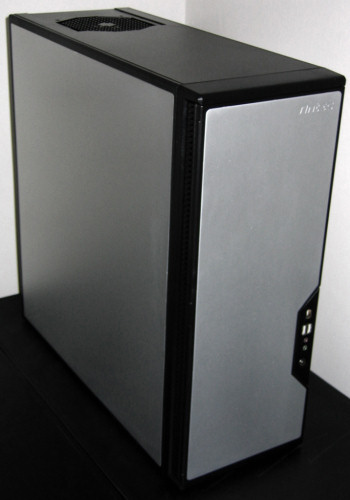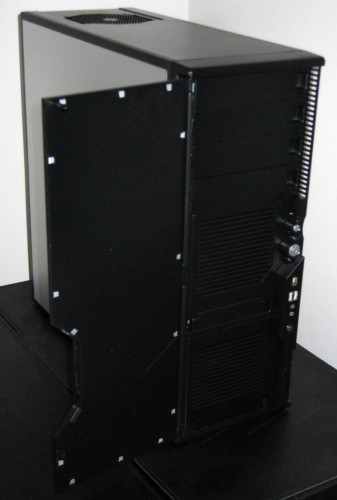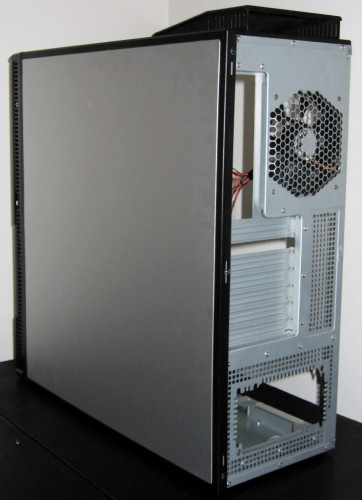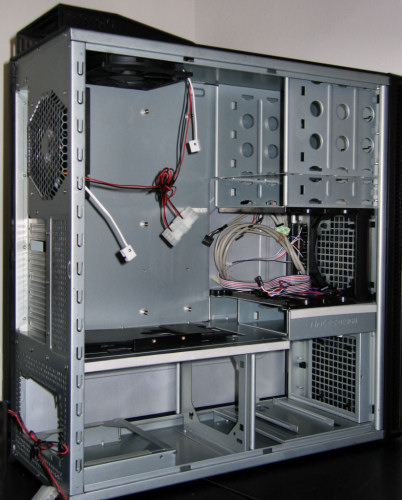Mid-Tower Mega Roundup
by Joshua Buss on September 8, 2005 12:05 AM EST- Posted in
- Cases/Cooling/PSUs
Antec P-180
The other case that we'll be looking at from Antec is the P-180. The case was available for as little as $110 - with most shops selling it for much closer to $130 - which is really amazing considering how much case you get for your money. This chassis has really been stirring things up within the community, and not without reason. Let's take a closer look to see what makes this unit so special.
From the outside, this is quite possibly the sleekest looking case that we've ever reviewed. The entire top is black and so is the trim around the edges, but the side and front panel are all aluminum with a silver colored matte finish.
The magnetically latched front door opens (and can continue swinging all the way to touch the side of the case, thanks to the double-hinge design) and reveals the four 5¼” drive bays, the single 3½” bay, and the two 120mm-sized air intakes. In order to pull in air with the solid door closed, the sides extending the door part forwards are lined with rectangular holes, which shouldn't hamper the case's ability to take in plenty of cool air. The filters behind the actual case intakes can be accessed easily by pushing on the hinged plastic grill on the right side.
Also viewable in this shot is the P-180's front panel connectors, which include the standard affair of Firewire, USB, and audio connections. Sitting on top at the back of the unit is a removable grill that is designed to help direct some of the warm exhaust air back. In this picture of the back of the case, this grill, the main rear 120mm fan, and the different placement of the power supply are all present.
Right away, we worried about power supply/motherboard compatibility with this case, as a bottom mounted power supply will need a long cable to reach the motherboard power connection comfortably. We'll find out if our test bed installed OK in a bit.
The side panels of the P-180 have a three-piece construction comprised of metal, plastic, and then metal again. The aim in this assembly is to help keep the case as quiet as possible, and since these panels resonate much less than a typical metal sheet, it will indeed do just that.
Once removed, we took most of the removable pieces out and were left with a very interesting, two-chamber design. Take a look:
The top portion houses the motherboard, all external drives, up to two hard drives, and two 120mm exhaust fans. The bottom chamber holds four more hard drives and the power supply, and can house one 120mm fan to keep this portion cool.
The other case that we'll be looking at from Antec is the P-180. The case was available for as little as $110 - with most shops selling it for much closer to $130 - which is really amazing considering how much case you get for your money. This chassis has really been stirring things up within the community, and not without reason. Let's take a closer look to see what makes this unit so special.
From the outside, this is quite possibly the sleekest looking case that we've ever reviewed. The entire top is black and so is the trim around the edges, but the side and front panel are all aluminum with a silver colored matte finish.
The magnetically latched front door opens (and can continue swinging all the way to touch the side of the case, thanks to the double-hinge design) and reveals the four 5¼” drive bays, the single 3½” bay, and the two 120mm-sized air intakes. In order to pull in air with the solid door closed, the sides extending the door part forwards are lined with rectangular holes, which shouldn't hamper the case's ability to take in plenty of cool air. The filters behind the actual case intakes can be accessed easily by pushing on the hinged plastic grill on the right side.
Also viewable in this shot is the P-180's front panel connectors, which include the standard affair of Firewire, USB, and audio connections. Sitting on top at the back of the unit is a removable grill that is designed to help direct some of the warm exhaust air back. In this picture of the back of the case, this grill, the main rear 120mm fan, and the different placement of the power supply are all present.
Right away, we worried about power supply/motherboard compatibility with this case, as a bottom mounted power supply will need a long cable to reach the motherboard power connection comfortably. We'll find out if our test bed installed OK in a bit.
The side panels of the P-180 have a three-piece construction comprised of metal, plastic, and then metal again. The aim in this assembly is to help keep the case as quiet as possible, and since these panels resonate much less than a typical metal sheet, it will indeed do just that.
Once removed, we took most of the removable pieces out and were left with a very interesting, two-chamber design. Take a look:
The top portion houses the motherboard, all external drives, up to two hard drives, and two 120mm exhaust fans. The bottom chamber holds four more hard drives and the power supply, and can house one 120mm fan to keep this portion cool.















48 Comments
View All Comments
RupertS - Thursday, September 8, 2005 - link
The power supply is a good part of the total value of the case. Also, some of the cases may work better (cooling, sound) with the power supply they come with.Hard to compare prices like this.
johnsonx - Thursday, September 8, 2005 - link
Ditto that... this complaint has been leveled before of course:Anandtech should at least mention what power supply is (or can be) included with the case, and give some sort of subjective rating of same. For example, the Aspire case is most often available with a 420W power supply (usually a mere $15 or so more than the PS-less version), but I've heard it's crap... but maybe it isn't; I'd like Anandtech to tell me.
Likewise, the Sonata II ALWAYS (AFAIK) includes a SmartPower 2.0 450... doesn't that add significantly to the value equation? (granted, it'd be better if it were a TruePower 380 like the old Sonata, but a SmartPower 2.0 is nothing to scorn)
ElFenix - Thursday, September 8, 2005 - link
everyone should read the reviews on SPCR before setting up a system on this case. the reviews are very thorough and tests it in multiple configurations, and it turns out there are things you can do to improve its thermal performance by quite a bit (such as duct taping over the holes next to the power supply)flatblastard - Thursday, September 8, 2005 - link
Duct tape on a brand new case? I don't think so..... Well, I personally wouldn't do it, but for modders/OCers I guess it might make sense.fass mut - Thursday, September 8, 2005 - link
what's the link to the article?ElFenix - Thursday, September 8, 2005 - link
all three articles, the first is over main features, the second is an absolutely silent computer, and the third is more mainstream rigshttp://www.silentpcreview.com/article249-page1.htm...">http://www.silentpcreview.com/article249-page1.htm...
http://www.silentpcreview.com/article254-page1.htm...">http://www.silentpcreview.com/article254-page1.htm...
http://www.silentpcreview.com/article255-page1.htm...">http://www.silentpcreview.com/article255-page1.htm...
jonp - Thursday, September 8, 2005 - link
Doesn't an ATX extension cable for $4 cover the power supply to motherboard distance concern? Granted, Antec could have included it with the case; but it's NO big deal to resolve. Shouldn't be an issued when deciding.mjz - Thursday, September 8, 2005 - link
i hate lian li cases. I spent probably 200 dollars on their case (2 years ago) and it vibrates too much, the sound is pissing me off. I guess it can't handle my raptor or something.Tamale - Thursday, September 8, 2005 - link
I too agree that way too many of these cases are kinda ridiculous looking, but someone said it best when they said "the Eclipse must look better in person"... it really does. I liken it to those fancy cd players from places like brookstone and the sharper image..It's flashy, sure, but at least it's kinda 'classy flashy', if you know what I mean. If that kinda look still doesn't please you at all, there's always cases like the P-180 ;)
mkruer - Thursday, September 8, 2005 - link
Considering that I have a PC-V2000 Plus. I am in a unique position to voice my opinion for everyone reading this thread. I will say that yes the cases Lian Li cases are overly expensive, but considering that they are the only “all aluminum” case manufacture, and they have arguably the best design, they can get away with it. The main issues with an “all aluminum” case is that because aluminum is light then steal and yet does not have the absorbing capacity of plastic, aluminum as rule of thumb tends to be louder. However there are three things you can do o improve the noise ratio of the system. First is to install sound absorbing foam in the case. This will cut down on high pitched noise. Next is to install quieter fans. The Lian Li fans are good, but they are only about average in the noise to air ratio. Finally and this is the biggest thing. In order to cut down on the “wan wan” resonance sound coming form the case you need to suspend the drive is a sling and not it the mounting bays. This by far reduces the most noise.